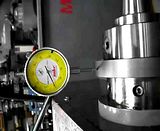Maryak
Well-Known Member
- Joined
- Sep 12, 2008
- Messages
- 4,990
- Reaction score
- 77
Yes, shrink fitting cast iron is a "Fine Line between Pleasure and Pain."
For parts operating at ambient temperature I would use a 1:1 fit. For parts at elevated temperatures, e.g. sleeving a pump steam cylinder. 0.0005" per inch of cylinder diameter, absolute maximum 0.001" per inch of diameter and that's only when you have plenty of meat left on the bored out for sleeve original. Any more interference and your liable to crack the original casting. Then you have to have a new one cast........................and "The Beat Goes On."
Amazing how the old pop songs fit real life. ;D
Best Regards
Bob
For parts operating at ambient temperature I would use a 1:1 fit. For parts at elevated temperatures, e.g. sleeving a pump steam cylinder. 0.0005" per inch of cylinder diameter, absolute maximum 0.001" per inch of diameter and that's only when you have plenty of meat left on the bored out for sleeve original. Any more interference and your liable to crack the original casting. Then you have to have a new one cast........................and "The Beat Goes On."
Amazing how the old pop songs fit real life. ;D
Best Regards
Bob





